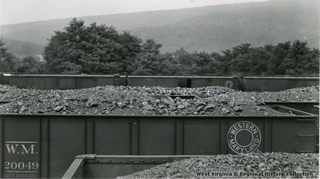
The Western Maryland Railway, which became a major natural resources carrier in the Eastern Panhandle, was chartered in May 1852 as the Baltimore, Carroll & Frederick Rail Road Company. Less than a year later, the name was changed to the Western Maryland Rail Road Company. The line was opened to Union Bridge, about 45 miles west of Baltimore, in November 1862. After the Civil War it was extended to Hagerstown in 1872 and then to a nearby connection with the Chesapeake & Ohio Canal in 1873.
Meanwhile, in 1866 Henry Gassaway Davis secured a charter from the West Virginia legislature for the Potomac & Piedmont Coal & Railroad Company. Davis was president, and his son-in-law, Stephen B. Elkins, was vice president. In 1880, construction began at a point on the Baltimore & Ohio Railway near Keyser. Within the year the name of Davis’s railroad was changed to the West Virginia Central & Pittsburg [sic], with initial construction in a southwestern direction to the coalfields around Elk Garden, Thomas, and Davis.
At first, the B&O controlled the only access to major markets for the coal and lumber shipped over the West Virginia Central. To escape this control, Davis and Elkins began a line toward Cumberland, Maryland, just across the Potomac River from West Virginia. Construction was completed to Cumberland in 1887, after near-violent opposition by the B&O.
Difficult construction through Black Fork Canyon brought the West Virginia Central to the new town of Elkins in 1889. By chartering subsidiary companies, Davis and Elkins continued to extend their railroad. In 1902, George Gould (son of the more famous railroad tycoon, Jay Gould) acquired the West Virginia Central and eventually merged it into the Western Maryland. Gould hoped to use the WM as the eastern end of a transcontinental railroad system and needed the West Virginia Central for its coal revenues.
George Gould pledged to extend the main Western Maryland line west along the Potomac from Big Pool, Maryland, to Cumberland, paralleling the West Virginia border on the Maryland side of the Potomac River. It was no easy task because the B&O Railroad, the C&O Canal, and several highways already had taken up the best locations along the river. Nonetheless, the line was completed in 1906, connecting the Western Maryland and the West Virginia Central. Two years later, the Gould empire collapsed and the WM went into receivership. In 1909, the Western Maryland Railway Company was organized, and one month later it purchased the old Western Maryland Rail Road Company’s property and equipment at a foreclosure sale. In the 1920s, the new WM purchased the Greenbrier, Cheat & Elk Railroad from the West Virginia Pulp & Paper Company. This line extended from Cheat Junction in Randolph County to Bergoo in Webster County. Acquisition of the West Virginia Midland Railway from Bergoo to Webster Springs completed the WM trackage in West Virginia.
The revitalized WM built north from Cumberland to a connection with the Pittsburgh & Lake Erie Railroad at Connellsville, Pennsylvania. This made the Western Maryland a major link between the East and the Midwest and transformed the railroad from a coal hauler to a major fast-freight line. Substantial improvements to track and terminals took place prior to World War I. John D. Rockefeller had gained a significant amount of the company’s stock as a result of the Gould collapse. Eventually the B&O purchased Rockefeller’s share of the Western Maryland, but the Interstate Commerce Commission determined the purchase to be in violation of the Clayton Act. Rather than give up the stock, the B&O placed it in a non-voting trust with the Chase National Bank of New York. There it remained until 1964, when the B&O, the C&O, and the WM gained permission to merge the three railroads into what became in 1972 the Chessie System and later CSX, now one of the two major rail systems operating in West Virginia.
This Article was written by Robert L. Frey
Last Revised on November 19, 2010
Related Articles
Sources
Cook, Roger & Karl Zimmerman. The Western Maryland Railway: Fireballs and Black Diamonds. San Diego: Howell-North Books, 1981.
Cite This Article
Frey, Robert L. "Western Maryland Railway." e-WV: The West Virginia Encyclopedia. 19 November 2010. Web. 26 July 2024.


Comments?
There aren't any comments for this article yet.
Click here to read and contribute to the discussion →